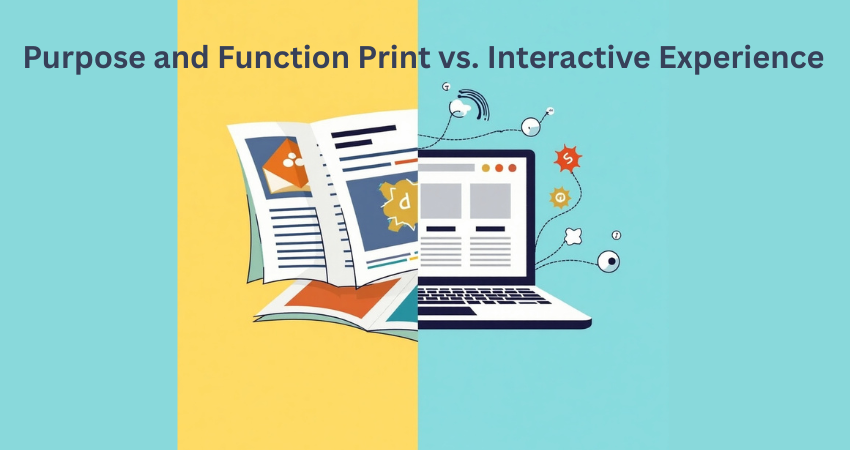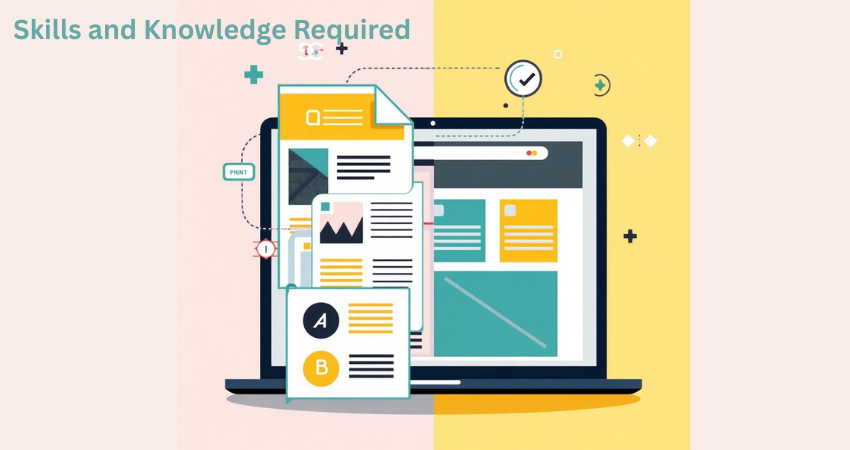
Purpose and Function Print vs. Interactive Experience
Although graphic design and web design seem to overlap somewhat in being visual, layout, and creative fields, once we get down to the core purposes of each profession, we see how these two areas begin to diverge sharply. Graphic design is usually tilted more toward designing for static environments—posters, packaging, and brand identity. It is focused on getting a message across at a glance.
Web design, on the flip side, creates interactive experiences. A website involves more than an image: it includes moving parts, clickable buttons, scrollable content, and responsive behavior across various devices. In web design, it’s not just about what they see, but how they interact with it.
This changes the game. Someone might have half an idea about a beautiful flyer that will be crafted to perfection and forsaken once it gets printed. The web designer has to be thinking about how that flyer interacts. When clicking this button, what happens? If I load this site on a phone, will anything change? How fast does the site load?
In graphic design, the design is the final product. In web design, the visuals are just part of a much larger living system. That’s where the real difference is-in how the user experiences and interacts with that work.
Designing for Static Media vs. Interactive Platforms
Control is the foundation of graphic design. Designers work with precise measurements, dimensions, and static color profiles (CMYK works in the print space). The end goal is to have something that looks the same regardless of whether it has been printed on a billboard, a brochure, or a magazine cover.
Web design cannot count on such concrete results. Each visitor may be using an altogether different browser, screen size, or device. Thus, a web designer must think in a fluid way: changes must be anticipated; layouts have to be flexible; and adaptability is key in design.
There’s also the element of time: in graphic design, everything somehow usually pops up to the audience’s view at once. With web design, however, the user gets led through a journey; sections appear as they scroll, content loads dynamically, and animation responds to the user’s input.
Now that’s a completely different way to think. Graphic designers look for a moment of impact. Web designers talk about engaging lasting experiences.
Tools and Software Used in Each Discipline
Although there is some overlap, graphic designers and web designers often choose different tools to carry out their work. This choice in tools signifies the differing requirements of these roles: graphic designers build static images while web designers build interactive interfaces.
Graphic designers work in the environment where visuals take top priority. Image editing and vector work are defined by Adobe Photoshop and Illustrator. InDesign is another great contender, especially for the layout of brochures or books. These tools were built from the ground up for pixel-perfect control over images, typography, and print materials.
Web designers, in contrast, operate between the aesthetic and the functional, between visuals and code. Interface design and prototype tools, like Figma and Adobe XD, will allow designers to speculate on how a site will behave and look. Web designers may refine their designs using HTML, CSS, and JavaScript or turn to Webflow or WordPress for implementation.
If graphic designers stayed at the level of visual conception, web designers went a step further: testing, tweaking, and launching live digital experiences.
Prototyping and Building for Functionality
Prototypes and interaction are some of the things that make web design stand apart. A website must function, unlike a logo or a poster. Web designers cannot merely showcase a finalized mock-up; they often must create interactive prototypes, sometimes even real front-end code, to test how the interface feels.
Tools like Figma, Sketch, or even Framer allow for interactive previews so that users get to click through menus, scroll pages or test animations. These prototypes are excellent for client presentations and the hand-off to development, but they also provide the designer with the opportunity to feel the site as a user would.
Graphic designers, on the other hand, do not typically deal in function. A poster either works or it doesn’t. It does not hover or have a loading state. Their version of proto-typing is less about user-interaction and more about layout and design iterations.
Realizing this distinction is important when considering which of the two you are trying to choose or planning to do both.
Skills and Knowledge Required

They rely on graphic designing and web designing through creativity and good visual sense. Beyond that, their competency is different. A graphic designer often composes; he uses colors, typography, and branding. A graphic designer’s job is to make messages or ideas visually compelling and emotionally resonant, perhaps at a glance.
While web designers need all those skills, they also need to be able to think more technically. An understanding of user experience (UX), accessibility standards, responsive design, and sometimes even a bit of front-end development is important for them. Their designs should look good and, at the same time, function well on real devices.
Communication is another shared skill, but that is particularly above the client. But then web designers might also work closely with developers, project managers, and SEO specialists. Meaning, they will have to learn across disciplines and be ready to problem-solve on the fly.
Hence, when graphic design is more about static but high-impact visuals, web design speaks of an absolutely hybrid kind of mindset that is creative and technical at the same time.
Learning Curves and Career Paths
The study of becoming a graphic designer is, many times, on art and design theory. You might study branding, print design, packaging, or even fine art. Much more important than what you know is your visual portfolio-arrangement of type, colors, or visuals in identity.
For web design, the learning curve throws in many ingredients. Only your strong design basics hold; the other side also delves into code, accessibility, UX principles, and user behavior online, and it’s a lot heavier to test and iterate.
That is the different career paths as well. Graphic designers might specialize in brand identity, editorial design, or marketing collateral. Web professionals can move towards UX design, front- end development, or maybe even product design.
There are no “better” ways- just different outcomes. Most creative professionals even prefer to learn both, creating hybrid designers capable of doing print and web. If you love visual storytelling, you will enjoy it either way. If you’re also into tech and interaction, maybe web is for you.
Collaboration and Delivery Processes
The designer works exactly how much is collaborative on two different fields. In graphic design, the projects tend to be more autocratic; a designer gets a brief, makes a concept, produces final files, and that’s normally where the job ends.
Web design projects are really more collaborative. A web designer might work with UX researchers, developers, content writers, SEO experts, and even testers. There are so many rounds of revisions and feedback. Once the design is done, there remains the build stage—and oftentimes, maintenance afterwards.
There’s also tool and hand-off. Graphic designers prepare files for printing. Web designers export assets, write documentation, or upload design systems into platforms like Zeplin or Figma for developers to work with.
When a graphic designer creates a finished product, web designers generally part create something living that evolves.
Timelines and Flexibility
Deadlines in graphic design are usually more set in stone. Once a flyer is printed or the logo approved, it is set in stone. Once the ink dries, there is no going back to change things.
Web design is altogether different; it is much more fluid. A site can be changed, a layout can be modified with a slight code change, a design can be adjusted based on feedback from users. This kind of flexibility is a joy and a headache; it gives you a lot of room for iteration but a lot of moving parts to keep track of.
If you are the sort of person who enjoys closure and having things in place, you might find more satisfaction in graphic design. Or, if working in progress and evolving on the job are what you enjoy, then web design might be your thing.
Conclusion
They may seem similar; however, the purposes, tools, and thought processes associated with graphic design and web design are quite distinct. One talks of static images and represents interactive experiences; the other brings forth a final product and generates ever-growing ideas.
With that, they are not enemies but, rather, partners in the work. The best branding comes out of graphic design and gets married to web design. An experienced designer understanding both disciplines bestows systematic and harmonious visuals to both print and digital.